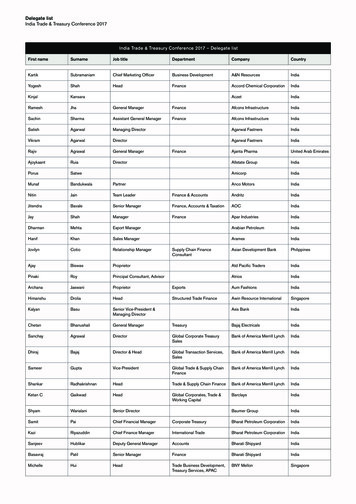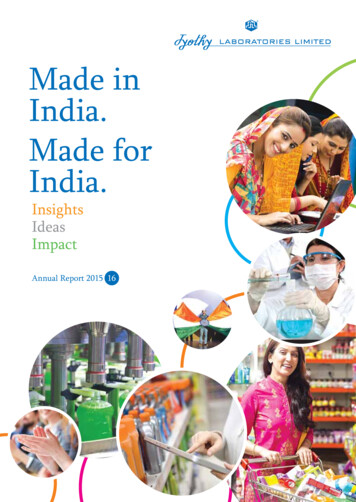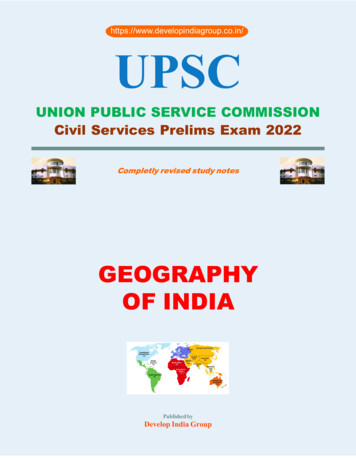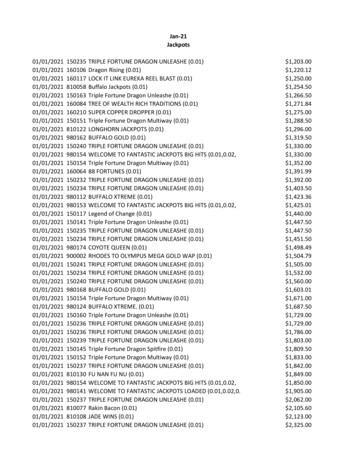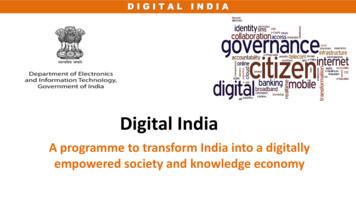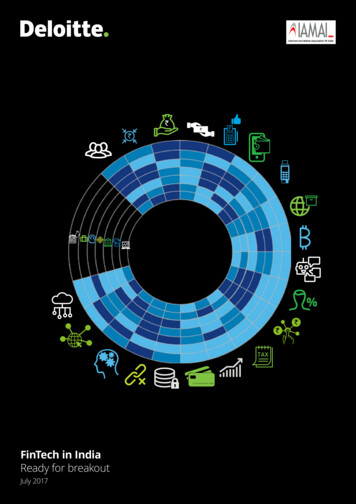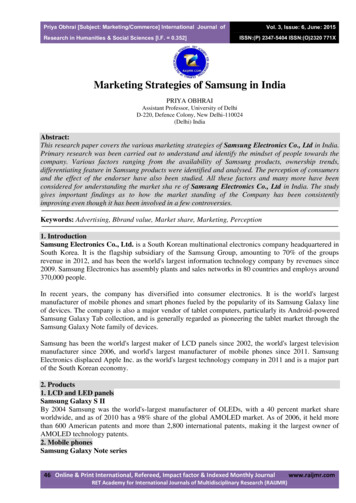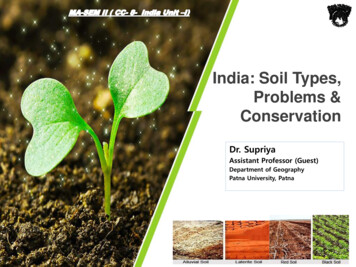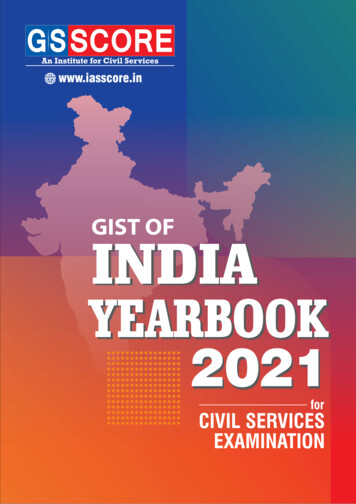
Transcription
www.iasscore.in INDIA YEAR BOOK - 2021Contents1. The Land and People . 012. National Symbols . 073. Polity . 094. Agriculture . 135. Commerce . 186. Communication and Information Technology . 237. Defence . 278. Education . 299. Energy . 3310. Environment . 3711. Finance . 4412. Corporate Affairs. 5813. Food, Civil Supplies and Consumer Affairs . 6214. Health and Family Welfare. 7115. Housing & Urban Affairs . 77
INDIA YEAR BOOK - 2021 www.iasscore.in16. India & The World . 7917. Industry . 8418. Law & Justice . 9219. LABOUR SKILL . 9820. & EMPLOYMENT . 9821. Mass Communication . 10522. Planning . 10923. Rural Development. 11424. Scientific & Technological Developments . 12025. Transport . 13026. Water Resources . 13727. Welfare . 14328. Youth Affairs & Sports. 155
www.iasscore.in INDIA YEAR BOOK - 202111The Land and People Physical Features" The mainland comprises four regions, namely,the great mountain zone, plains of the Ganga andthe Indus, the desert region and the southernpeninsula.India at a Glance:" The mountain wall extends over a distance ofabout 2,400 km with a varying depth of 240 to320 km. Geographical Area: 32,87,263 sq.Km (seventh largest country in theworld) Latitude & Longitude: The mainlandextends between latitudes 8 4’ and37 6’ north, longitudes 68 7’ and97 25’ east. Distance: from north to south:about 3,214 km between theextreme latitudes and about 2,933km from east to west between theextreme longitudes. Land frontier of about 15,200 km.The total length of the coastline ofthe mainland, Lakshadweep Islandsand Andaman and Nicobar Islands is7,516.6 km. Bordering Countries: Afghanistanand Pakistan to the north-west,China, Bhutan and Nepal to thenorth, Myanmar to the far East andBangladesh to the east. Sri Lanka isseparated from India by a narrowchannel of sea formed by the PalkStrait and the Gulf of Mannar. Divided into six zones mainly north,south, east, west, central and northeast zone and It has 29 states andseven union territories" In the east, between India and Myanmar and Indiaand Bangladesh, hill ranges are much lower." Garo, Khasi, Jaintia and Naga Hills, running almosteast-west, join the chain to Mizo and Rakhine Hillsrunning north-south." The plains of the Ganga and the Indus, about2,400 km long and 240 to 320 km broad, areformed by basins of three distinct river systems—the Indus, the Ganga and the Brahmaputra." The desert region can be divided into two parts—the ‘great desert’ and the ‘little desert’." The great desert extends from the edge of the Rannof Kutch beyond the Luni river northward. Thewhole of the Rajasthan-Sind frontier runs throughthis." The little desert extends from the Luni betweenJaisalmer and Jodhpur up to the northern west." The Peninsular Plateau is marked off from the plainsof the Ganga and the Indus by a mass of mountainand hill ranges varying from 460 to 1,220 metresin height. Prominent among these are the Aravali,Vindhya, Satpura, Maikala and Ajanta ." The southern point of the plateau is formed by theNilgiri Hills where the Eastern and the WesternGhats meet." The Cardamom Hills lying beyond may be regardedas a continuation of the Western Ghats.Notable Passes: Jelep La and Nathu La on the mainIndo-Tibet trade route through theChumbi valley, north-east of Darjeelingand Shipki La in the Satluj valley, northeast of Kalpa (Kinnaur)Geological Structure" The geological regions broadly follow the physicalfeatures and may be grouped into three regions:
INDIA YEAR BOOK - 2021 2 www.iasscore.inthe Himalayas and their associated group of mountains, the Indo-Gangetic Plain and thePeninsular Shield." The Himalayan mountain belt to the north and the Naga-Lushai mountain in the east, are the regionsof mountain-building movement (by compression of sendiment and basement rocks)"The Indo-Ganga plains are a great alluvial tract that separates the Himalayas in the north from thePeninsula in the south." The Peninsula is a region of relative stability and occasional seismic disturbances (igneous, metamorphand Deccan Trap formation). River Systems" The river systems of India can be classified into four groups viz.,y Himalayan rivers,y Deccan rivers,y Coastal rivers andy Rivers of the inland drainage basin." The Himalayan Rivers are formed by melting snow and glaciers and therefore, continuously flowthroughout the year. The main Himalayan river systems are those of the Indus and the GangaBrahmaputra-Meghna system." The Deccan Rivers on the other hand are rain-fed and therefore fluctuate in volume. Many ofthese are non perennial. In the Deccan region, most of the major river systems flowing generally inthe east fall into Bay of Bengal.
www.iasscore.in INDIA YEAR BOOK - 20213" The major east flowing rivers are Godavari, Krishna, Cauvery and Mahanadi. Narmada and Tapti aremajor west flowing rivers. The Godavari in the southern Peninsula has the second largest riverbasin covering 10 per cent of the area of India." The Coastal streams, especially on the west coast are short in length and have limited catchmentareas. Most of them are non-perennial." The streams of inland drainage basin of western Rajasthan few rivers in Rajasthan do not draininto the sea. These are Luni, Machhu, Rupen, Saraswati, Banas, Ghaggar and others." The entire country has been divided into 20 river basins/group of river basins comprising 12major basins and eight composite river basins. The 12 major river basins are : (1) Indus, (2) GangaBrahmaputra-Meghna, (3) Godavari, (4) Krishna, (5) Cauvery, (6) Mahanadi, (7) Pennar, (8) BrahmaniBaitarani, (9) Sabarmati, (10) Mahi, (11) Narmada and (12) Tapti. Each of these basins has a drainagearea exceeding 20,000 sq. km." The eight composite river basins combining suitably together all the other remaining medium(drainage area of 2,000 to 20,000 sq. km) and small river systems (drainage area less than 2000sq. km) for the purpose of planning and management. Climate/Seasons" The climate of India may be broadly described as tropical monsoon type. The Indian MeteorologicalDepartment (IMD) designates four official seasons:y Winter, from December to early April.y Summer or pre-monsoon season, lasting from April to June (April to July in north-western India).y Monsoon or rainy season, lasting from June to September. The season is dominated by the humidsouth-west summer monsoon.y Post-monsoon season, lasting from October to December. In north-western India, October andNovember are usually cloudless." India’s climate is affected by two seasonal winds—the north-east monsoon and the south-westmonsoon. The north-east monsoon commonly known as winter monsoon blows from land to sea.The south-west monsoon brings most of the rainfall during the year in the country. Flora" India is rich in flora. From about 70 per cent geographical area surveyed so far, over 46,000 speciesof plants have been described by the Botanical Survey of India (BSI), Kolkata." The vascular flora, which forms the conspicuous vegetation cover, comprises 15,000 species." India can be divided into eight distinct floral regions, namely, the western Himalayas, the easternHimalayas, Assam, the Indus plain, the Ganga plain, the Deccan, the Malabar and the Andamans." The western Himalayan region extends from Kashmir to Kumaon. Its temperate zone is rich inforests of chir, pine, other conifers and broad-leaved temperate trees. Higher up, forests ofdeodar, blue pine, spruce and silver fir occur." The eastern Himalayan region extends from Sikkim eastwards and embraces Darjeeling,Kurseong and the adjacent tracts. The temperate zone has forests of oaks, laurels, maples,rhododendrons, alder and birch." The Indus plain region comprises the plains of Punjab, western Rajasthan and northern Gujarat.It is dry, hot and supports natural vegetation." The Ganga plain region covers the area which is alluvial plain and is under cultivation for wheat,sugarcane and rice." The Deccan region comprises the entire table land of the Indian Peninsula and supports vegetationof various kinds from shrub jungles to mixed deciduous forests." The Malabar region covers the excessively humid belt of mountain country parallel to the westcoast of the Peninsula. Besides being rich in forest vegetation, this region produces importantcommercial crops, such as coconut, betelnut, pepper, coffee, tea, rubber and cashewnut.
4INDIA YEAR BOOK - 2021 www.iasscore.in" The Andaman region abounds in evergreen, mangrove, beach and diluvial forests." Owing to destruction of forests for agricultural, industrial and urban development, several Indianplants are facing threat of extinction. About 1,336 plant species are considered vulnerable andendangered. BSI brings out an inventory of endangered plants in the form of a publication titled‘Red Data Book.’ Faunal Resources" India is very rich in terms of biological diversity due to its unique biogeographical location,diversified climate conditions and enormous ecodiversity and geodiversity." India’s immense biological diversity encompasses ecosystems, populations, species and their geneticmake-up." According to world biogeographic classification, India represents two of the major realms (thePalearctic and Indo-Malayan) and three biomes (Tropical Humid Forests, Tropical Dry/DeciduousForests and Warm Deserts/Semi-Deserts)." The Wildlife Institute of India has proposed a modified classification which divides the country intoten biogeographic regions: Trans- Himalayan, Himalayan, Indian Desert, Semi-Arid, Western Ghats,Deccan Peninsula, Gangetic Plain, North-East India, Islands and Coasts." Within only about 2 per cent of world’s total land surface, India is known to have over 7.50 per centof the species of animals that the world holds.DEMOGRAPHIC BACKGROUND Census 2011 was the 15th Census of its kind since 1872" Populationy The population of India as on March 1, 2011 stood at 1,210.9 million (623.2 million males and587.6 million females). Currently it is estimated at near 138 crors.y India accounts for a meagre 2.4 per cent of the world surface area of 135.79 million sq.km. Yet, itsupports and sustains a whopping per cent (17.7%) of the world population." Population Densityy The population density of India in 2011 was 382 per sq. km-decadal growth 17.72 per cent.y The density of population increased in all states and union territories between 1991 and 2011.Among major states, Bihar is the most thickly populated state with (a population density of)1,106 persons per sq.km followed by West Bengal 1,028 and Kerala 860." Sex Ratioy Sex ratio, defined as the number of females per thousand males is an important social indicator tomeasure the extent of prevailing equality between males and females in a society at a given pointof time.
www.iasscore.in INDIA YEAR BOOK - 20215y The sex ratio in the country has always remained unfavourable to females. As per the census 2011the sex ratio in India is 943 per 1000 males which were 933 in the previous census 2001.y Child sex ratio has declined to 919 per thousand male." Literacyy For the purpose of census 2011, a person aged seven and above, who can both read and writewith understanding in any language, is treated as literate.yThe literacy rate in the country is 73.0 per cent, 80.9 for males and 64.6 for females.yKerala retained its position by being on top with a 94 per cent literacy rate, closely followed byLakshadweep (91.9 per cent). Bihar with a literacy rate of 61.8 per cent ranks last in the country.y Bihar has recorded the lowest literacy rates both in case of males (71.2 per cent) and females(51.5 per cent). Migration" Census of India records migration by two methods, namely: place of last residence and place ofbirth." About 455.8 million peop le were treated as migrants by place of last residence, 141.9 million wereconsidered to be migrants between the period 2001 and 2011.
6 www.iasscore.inINDIA YEAR BOOK - 2021 " And a major chunk of the migrants in India (84.8 per cent) in the period 2001-2011 were within thestate of enumeration." Only 15.6 per cent of migrants were considered inter-state migrants." Similarly, within the states/union territories, 64.9 per cent of the migration in the period 20012011happened within the district of enumeration and the rest 35.1 per cent migrants were inter-districtmigrants. Fertility and Mortality Rates" A TFR of about 2.1 children per woman is called Replacement-level fertility." From a TFR of 2.6 in 2008 to 2.2 in 2018, India has gradually moved towards achieving the replacementlevel of fertility." Crude Birth Ratey CBR in India has reached 20.0 per 1,000 population in 2018." Crude Death Ratey The Crude Death Rate for India in 2018 was 6.2 per 1,000 population, gradually down from 7.4 in2008." Infant Mortality Ratey India has been able to drastically reduce the Infant Mortality Rate from 53 in 2008 to 32 in 2018.**********
www.iasscore.in INDIA YEAR BOOK - 202172National SymbolsThe Republic of India has several official national symbols. These symbols are intrinsic to the Indian identityand heritage. These are discussed as follows: National Flag" Featuresy The National Flag is a horizontal tricolor of deep saffron (kesaria) at the top, white in the middleand dark green at the bottom in equal proportion.y The ratio of width of the flag to its length is 2:3. In the center of the white band is a navy-bluewheel which represents the chakra.y Its design is that of the wheel which appears on the abacus of the Sarnath Lion Capital of Ashoka.Its diameter approximates to the width of the white band and it has 24 spokes.y The design of the National Flag was adopted by the Constituent Assembly of India on July 22,1947.y The flag is based on the Swaraj flag, a flag of the Indian National Congress designed by PingaliVenkayya." Constitutional & Statutory Provisions Related to National Flagy Art 51A(a) - To abide by the Constitution and respect its ideals and institutions, the National Flagand the National Anthem." Statutes Governing Use of Flagy Emblems and Names (Prevention of Improper Use) Act, 1950y Prevention of Insults to National Honor Act, 1971" Flag Code of India, 2002y There is no restriction on the display of the National Flag by members of general public, privateorganizations, educational institutions, etc., except as provided for by the above statutes.y Half-mast: The flag should be flown at half-mast as a sign of mourning. The decision to do so lieswith the President of India, who also decides the period of such mourning." SignificanceAs clarified by Sarvepalli Radhakrishnan, its significance is as follows:y The saffron color denotes renunciation or disinterestedness.y The white in the center is light, the path of truth to guide our conduct.y The green shows our relation to the soil, our relation to the plant life here, on which all other lifedepends.y The “Ashoka Chakra” is the wheel of the law of dharma.
8 INDIA YEAR BOOK - 2021 www.iasscore.inState Emblem" Featuresy Adapted from the Sarnath Lion Capitol of Ashoka, it is carved out of a single block of polishedsandstone. The Capitol is crowned by the Wheel of the Law.y In the state emblem, adopted by the Government of India (by Madhav Sawhney) in 1950 on January26, 1950, only 3 lions are visible.y The wheel appears in the center of the abacus with a bull on right and a horse on left.y The outlines of other wheels on extreme right and left. The bell-shaped lotus has been omitted.y The words Satyameva Jayate from Mundaka Upanishad, meaning ‘Truth Alone Triumphs’, areinscribed below the abacus in Devanagari script.y The use of the state emblem, as the official seal of the Government of India, is regulated by theState of India (Prohibition of Improper Use) Act, 2005. No individual or private organization ispermitted to use the emblem for official correspondence. National Anthem" The song Jana-gana-mana, composed originally in Bengali by Rabindranath Tagore, was adopted inits Hindi version as the National Anthem of India on January 24, 1950." First sung on December 27, 1911 at the Kolkata Session of the Indian National Congress, the durationof the National Anthem is approximately 52 seconds. National Song" The song Vande Mataram, composed in Sanskrit by Bankimchandra Chatterji, was a source ofinspiration to the people in their struggle for freedom." It has an equal status with Jana-gana-mana." It was first sung at the 1896 session of the Indian National Congress. National Calendar" The National Calendar based on the Saka Era, with Chaitra as its first month and a normal year of 365days was adopted from March 22, 1957 along with the Gregorian calendar for:y Gazette of Indiay News broadcast by All India Radioy Calendars issued by the Government of Indiay Government communications addressed to the public." Dates of the National Calendar have a permanent correspondence with dates of the Gregoriancalendar, 1 Chaitra falling on March 22 normally and on March 21 in leap year.Other national symbols National Flower: Indian Lotus (Nelumbo nucifera) National Fruit: Mango Mango (Mangifera indica) National River: Ganga National Tree: Indian banyan (Ficus bengalensis) National Animal: Royal Bengal Tiger (Panthera tigristigris) National Aquatic Animal: Gangetic dolphin (Platanista gangetica). National Bird: Indian peacock (Pavo cristatus) National Currency: Indian Rupee (sign: ; code: INR)
www.iasscore.in INDIA YEAR BOOK - 202193PolityINDIA, a union of states, is a Sovereign Socialist Secular Democratic Republic with a parliamentarysystem of government. The Republic is governed in terms of the Constitution, which was adopted byConstituent Assembly on November 26, 1949 and came into force on January 26, 1950. The Constitutionwhich envisages parliamentary form of government is federal in structure with unitary features." The President of India is the constitutional head of executive of the union. Article 74(1) of theConstitution provides that there shall be a Council of Ministers with the Prime Minister as its head toaid and advise the President who shall in exercise of his functions, act in accordance with such advice.The real executive power thus vests in the Council of Ministers with the Prime Minister as its head." The Constitution distributes legislative power between Parliament and State Legislatures andprovides for vesting of residual powers in Parliament. The power to amend the Constitution alsovests in Parliament. The Constitution has provision for independence of Judiciary, Comptroller andAuditor-General, Public Service Commissions and Chief Election Commission." The functions of Parliament are varied in nature. The time at its disposal is limited. It cannot makevery detailed scrutiny of all legislative and other matters that come up before it. A good deal ofParliamentary business is, therefore, transacted in the committees." Both Houses of Parliament have a similar committee structure, with few exceptions. Their appointment,terms of office, functions and procedure of conducting business are also more or less similar and areregulated as per rules made by the two Houses under Article 118(1) of the Constitution. Citizenship" Citizenship (Amendment) Acty The amended Act makes foreign illegal migrants of six religious communities, i.e., Hindu, Sikh,Buddhist, Jain, Parsi and Christian from Afghanistan, Bangladesh and Pakistan eligible for Indiancitizenship.y It is applicable to those who have taken shelter in India due to persecution on grounds of religionor fear of such persecution in their countries and have entered into India on or before December31, 2014.y The Third Schedule to the Act has been amended to make applicants belonging to the saidcommunities from the three countries eligible for citizenship by naturalisation, if they can establishtheir residency in India for five years instead of the previous requirement of eleven years.y The provisions of the Act, however, do not apply to tribal areas of Assam, Meghalaya, Mizoram andTripura as included in the Sixth Schedule to the Constitution and the areas where ‘The Inner LinePermit’ is applicable including the states of Arunachal Pradesh, Nagaland, Mizoram and Manipur. Fundamental Rights" The Constitution offers all citizens, individually and collectively, some basic freedoms. These areguaranteed in the Constitution in the form of six broad categories of Fundamental Rights which arejusticiable. Articles 12 to 35 contained in Part III of the Constitution deal with Fundamental Rights.
10 INDIA YEAR BOOK - 2021 www.iasscore.inDirective Principles of State Policy" The Constitution lays down certain Directive Principles of State Policy, which though not justiciable,are ‘fundamental in governance of the country’ and it is the duty of the state to apply these principlesin making laws. These have been contained in Part IV from Articles 36 to 51 of the Constitution. The Union Executive" The Union executive consists of the President, the Vice-President and the Council of Ministers with thePrime Minister as the head to aid and advise the President. Legislature" Legislature of the Union which is called Parliament, consists of the President and two Houses, knownas Council of States (Rajya Sabha), and House of the People (Lok Sabha). Each House has to meetwithin six months of its previous sitting. A joint sitting of two Houses can be held in certain cases. Government Business in Parliament" The Minister of Parliamentary Affairs is entrusted with coordinating, planning and arranginggovernment business in both Houses of Parliament. In discharge of this function, he is assisted bytwo ministers of state. Consultative Committees" Functioning of Consultative Committees of Members of Parliament for various ministries is one of thefunctions allocated to the Ministry of Parliamentary Affairs under the Government of India (Allocationof Business) Rules, 1961." The minimum membership of a Consultative Committee is ten and the maximum membership isthirty." The Consultative Committee stands dissolved upon dissolution of every Lok Sabha and arereconstituted upon constitution of each Lok Sabha. Parliamentary Committees Youth Parliament Competition" In order to develop democratic ethos in the younger generation the Ministry conducts YouthParliament Competitions in various categories of schools and colleges/universities.
www.iasscore.in INDIA YEAR BOOK - 202111Cabinet Secretariat" The Cabinet Secretariat functions directly under the Prime Minister." The administrative head of the Secretariat is the Cabinet Secretary who is also the ex-officio Chairmenof the Civil Services Board." The business allocated to Cabinet Secretariat is (i) secretarial assistance to the Cabinet and CabinetCommittees; and (ii) rules of business." It facilitates smooth transaction of business in ministries/departments of the government by ensuringadherence to these rules." It assists in decision-making by ensuring inter-ministerial coordination, ironing out differencesamongst ministries/departments and evolving consensus through the instrumentality of the standingand ad hoc Committees of Secretaries. National Authority for Chemical Weapons Convention" The Convention on the Prohibition of the Development, Production, Stockpiling and Use of ChemicalWeapons is a multilateral international treaty which outlaws the production, stockpiling, and use ofchemical weapons and their precursors. The CWC came into force with effect from 1997." The National Authority for Chemical Weapons Convention (NACWC) was set up as an office of theCabinet Secretariat, on behalf of the Government of India, the obligations under the Chemical WeaponsConvention (CWC) and to act as the national focal point for effective liaison with the Organizationfor the Prohibition of Chemical Weapons (OPCW) and other state parties on matters relating to theConvention. National Disaster Management Authority" In 2005, the government enacted the Disaster Management Act, which envisaged the creation ofNational Disaster Management Authority, under the Ministry of Home Affairs, headed by the PrimeMinister, and State Disaster Management Authorities (SDMAs) headed by respective Chief Ministers,to spearhead and implement a holistic and integrated approach to disasters management in thecountry. Administrative Reforms and Public Grievances" The Department of Administrative Reforms and Public Grievances (DARPG) is the nodal agency of theGovernment of India for administrative reforms as well as redressal of public grievances relating thestates in general and those pertaining to central government agencies in particular. Prime Minister’s Award for Excellence in Public Administration" Government of India instituted ‘Prime Minister’s Award for Excellence in Public Administration’ toacknowledge, recognize and reward the extraordinary and innovative work done by officers of thecentral and state governments. Civil Services Day" The Government of India celebrates April, 21 every year as ‘Civil Services Day’ for the civil servantsto rededicate themselves to the cause of citizens and renew their commitment to public service andexcellence in work. National Conference on e-Governance" The Department of Administrative Reforms and Public Grievances (DARPG) along with the Ministry ofElectronics and Information Technology in association with one of the state governments organisesthe National Conference on e-Governance every year since 1997.
12 www.iasscore.inINDIA YEAR BOOK - 2021 National e-Governance Service Delivery Assessment" National e-Governance Service Delivery Assessment (NeSDA) aims at assessing the states, UTs andcentral ministries on the depth and efficiency of e- Governance service delivery." The United Nations Department of Economic and Social Affairs (UNDESA) brings out the UNe-Government Survey every two years which provides an analysis of progress in using e-Government.India stood at 118 in 2014 which improved to 107 in 2016 and 96 in 2018, out of 193 membercountries. e-Office Project" e-Office is one of the important Mission Mode Projects for implementing the Digital India Plan." The DAR & PG is the administrative ministry for ensuring e-Office implementation." It aims to increase the usage of workflow and rule based fi le routing, quick research and retrieval offiles and office order, digital signatures, forms and reporting components. Dashboard for Covid-19 Grievances" During preventive lockdown in the wake of Covid-19 pandemic, DARPG started special drive to redresslock down and Covid-19 related grievances in shortest possible time. To ensure dedicated monitoringof those grievances a separate National Monitoring Dashboard for Covid-19 grievances was created." All central ministries and state governments have nominated a nodal officer for prompt disposal ofsuch grievances. Good Governance Index" DARPG has developed Good Governance Index (GGI) for ten key sectors across 50 indicators. Theseindicators can be used to assess the status of governance and impact of various interventions takenup by the state governments and the union territories for improving governance." First edition of GGI was released by DARPG on December 25,2020 on the occasion of Good GovernanceDay. Integration of Awaaz-e-Awam with CPGRAMS" Public grievance portal of union territory of Jammu and Kashmir has been integrated with CentralizedPublic Grievance Portal of Government of India for seamless transfer of grievances to the authoritiesresponsible for redressal and effective monitoring for their prompt disposal. National Centre of Good Governance" National Centre of Good Governance (NCGG) is an autonomous institute under DARPG which servesas a think tank for governance and policy reforms, cutting across administrative, social, economic andfinancial spheres." It functions as a national repository on information on best practices, initiatives and methodologiesthat promote good governance, e-Governance, innovation and change management within thegovernment.**********
www.iasscore.in INDIA YEAR BOOK - 2021134AgricultureAgriculture plays a vital role in India’s economy. 54.6 per cent of the population is engaged in agricultureand allied activities (census 2011) and it contributes 17.4 per cent to the country’s Gross Value Added(current price 2016-17). Given the importance of this sector
and Pakistan to the north-west, China, Bhutan and Nepal to the north, Myanmar to the far East and separated from India by a narrow channel of sea formed by the Palk Strait and the Gulf of Mannar. Divided into six zones mainly north, south, east, west, central and north-east zone and It
